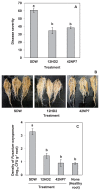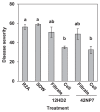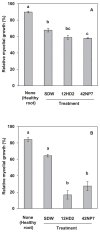Suppressive potential of Paenibacillus strains isolated from the tomato phyllosphere against fusarium crown and root rot of tomato
- PMID: 24920171
- PMCID: PMC4103523
- DOI: 10.1264/jsme2.me13172
Suppressive potential of Paenibacillus strains isolated from the tomato phyllosphere against fusarium crown and root rot of tomato
Abstract
The suppressive potentials of Bacillus and Paenibacillus strains isolated from the tomato phyllosphere were investigated to obtain new biocontrol candidates against Fusarium crown and root rot of tomato. The suppressive activities of 20 bacterial strains belonging to these genera were examined using seedlings and potted tomato plants, and two Paenibacillus strains (12HD2 and 42NP7) were selected as biocontrol candidates against the disease. These two strains suppressed the disease in the field experiment. Scanning electron microscopy revealed that the treated bacterial cells colonized the root surface, and when the roots of the seedlings were treated with strain 42NP7 cells, the cell population was maintained on the roots for at least for 4 weeks. Although the bacterial strains had no direct antifungal activity against the causal pathogen in vitro, an increase was observed in the antifungal activities of acetone extracts from tomato roots treated with the cells of both bacterial strains. Furthermore, RT-PCR analysis verified that the expression of defense-related genes was induced in both the roots and leaves of seedlings treated with the bacterial cells. Thus, the root-colonized cells of the two Paenibacillus strains were considered to induce resistance in tomato plants, which resulted in the suppression of the disease.
Figures








Similar articles
-
Biocontrol of Fusarium wilt disease in tomato by Paenibacillus ehimensis KWN38.World J Microbiol Biotechnol. 2015 Jan;31(1):165-74. doi: 10.1007/s11274-014-1771-4. Epub 2014 Nov 11. World J Microbiol Biotechnol. 2015. PMID: 25384610
-
Plant growth-promoting rhizobacteria, Paenibacillus polymyxa and Paenibacillus lentimorbus suppress disease complex caused by root-knot nematode and fusarium wilt fungus.J Appl Microbiol. 2009 Aug;107(2):524-32. doi: 10.1111/j.1365-2672.2009.04238.x. Epub 2009 May 19. J Appl Microbiol. 2009. PMID: 19457027
-
Characterization of endophytic Bacillus strains from tomato plants (Lycopersicon esculentum) displaying antifungal activity against Botrytis cinerea Pers.World J Microbiol Biotechnol. 2015 Dec;31(12):1967-76. doi: 10.1007/s11274-015-1943-x. Epub 2015 Sep 7. World J Microbiol Biotechnol. 2015. PMID: 26347324
-
In situ evaluation of Paenibacillus alvei in reducing carriage of Salmonella enterica serovar Newport on whole tomato plants.Appl Environ Microbiol. 2014 Jul;80(13):3842-9. doi: 10.1128/AEM.00835-14. Epub 2014 Apr 18. Appl Environ Microbiol. 2014. PMID: 24747888 Free PMC article.
-
Paenibacillus as a Biocontrol Agent for Fungal Phytopathogens: Is P. polymyxa the Only One Worth Attention?Microb Ecol. 2024 Oct 31;87(1):134. doi: 10.1007/s00248-024-02450-8. Microb Ecol. 2024. PMID: 39480531 Free PMC article. Review.
Cited by
-
Phytochrome-mediated shade avoidance responses impact the structure and composition of the bacterial phyllosphere microbiome of Arabidopsis.Environ Microbiome. 2025 Feb 6;20(1):20. doi: 10.1186/s40793-025-00679-5. Environ Microbiome. 2025. PMID: 39915883 Free PMC article.
-
Effects of Rhizobium Species Living with the Dark Septate Endophytic Fungus Veronaeopsis simplex on Organic Substrate Utilization by the Host.Microbes Environ. 2018 Mar 29;33(1):102-106. doi: 10.1264/jsme2.ME17144. Epub 2018 Mar 20. Microbes Environ. 2018. PMID: 29459501 Free PMC article.
-
Diagnosis of Induced Resistance State in Tomato Using Artificial Neural Network Models Based on Supervised Self-Organizing Maps and Fluorescence Kinetics.Sensors (Basel). 2022 Aug 10;22(16):5970. doi: 10.3390/s22165970. Sensors (Basel). 2022. PMID: 36015731 Free PMC article.
-
Bacillus-related Spore Formers: Attractive Agents for Plant Growth Promotion.Microbes Environ. 2015;30(3):205-7. doi: 10.1264/jsme2.me3003rh. Microbes Environ. 2015. PMID: 26672135 Free PMC article. No abstract available.
-
Potential for Biocontrol of Hairy Root Disease by a Paenibacillus Clade.Front Microbiol. 2017 Mar 22;8:447. doi: 10.3389/fmicb.2017.00447. eCollection 2017. Front Microbiol. 2017. PMID: 28382027 Free PMC article.
References
-
- Algam SAE, Xie G, Li B, Yu S, Su T, Larsen J. Effects of Paenibacillus strains and chitosan on plant growth promotion and control of Ralstonia wilt in tomato. J Plant Pathol. 2010;92:593–600.
-
- Bolwerk A, Lagopodi AL, Lugtenberg BJJ, Bloemberg GV. Visualization of interactions between a pathogenic and beneficial Fusarium strain during biocontrol of tomato foot and root rot. Mol Plant Microbe Interact. 2005;18:710–721. - PubMed
-
- Chin-A-Woeng TFC, Bloemberg GV, Mulders IHM, Dekkers LC, Lugtenberg BJJ. Root colonization by phenazine-1- carboxamide-producing bacterium Pseudomonas chlororaphis PCL1391 is essential for biocontrol of tomato foot and root rot. Mol Plant Microbe Interact. 2000;13:1340–1345. - PubMed
-
- Choudhary DK, Johri BN. Interactions of Bacillus spp. and plants—with special reference to induced systemic resistance (ISR) Microbiol Res. 2009;164:493–513. - PubMed
-
- Danhash N, Wagemakers CA, Van Kan JAL, de Wit PJ. Molecular characterization of four chitinase cDNAs obtained from Cladosporium fulvum-infected tomato. Plant Mol Biol. 1993;22:1017–1029. - PubMed
Publication types
MeSH terms
Substances
LinkOut - more resources
Full Text Sources
Other Literature Sources
Molecular Biology Databases

